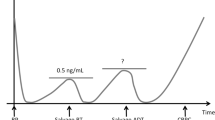Abstract
Purpose
To examine the prognosis after BCR with and without salvage therapy, including radiation and/or androgen deprivation.
Methods
The study population consisted of 431 patients, all of whom underwent radical prostatectomy and developed BCR (PSA > 0.2 ng/mL). According to the two risk factors [Gleason score ≥ 8 and PSA-doubling time (DT) < 6 months], we divided the patients into two groups. The high/intermediate-risk group consisted of patients with both or one risk factor. On the other hand, patients with neither factor were in the low-risk group. We set the starting point at the timing of BCR, and the endpoints were development to castration-resistant prostate cancer (CRPC) and cancer-specific death.
Results
During the mean follow-up period of 8.3 years after BCR, CRPC was observed in 49 patients (11.4%), and 21 patients (4.9%) died due to prostate cancer. We first divided the 191 high/intermediate-risk patients according to the PSA level (PSA < 1.0 ng/mL, PSA 1.0–4.0, and PSA > 4.0 or no therapy) at the initiation of salvage therapy, including radiation and/or androgen deprivation. We found that delayed (PSA > 4.0 ng/mL) or no salvage therapy was significantly associated with CRPC and cancer-specific death. In the 240 low-risk patients, Kaplan–Meier curves demonstrated no significant difference in CRPC-free survival or cancer-specific survival within 10 years from the timing of BCR.
Conclusions
Observation after BCR without salvage therapy or delayed administration may be an option for low-risk patients with a Gleason score ≤ 7 and PSA-DT ≥ 6 months when their life expectancy is within 10 years.


Similar content being viewed by others
References
Hamdy FC, Donovan JL, Lane JA, ProtecT Study Group et al (2016) 10-Year outcomes after monitoring, surgery, or radiotherapy for localized prostate cancer. N Engl J Med 375:1415–1424
Cookson MS, Aus G, Burnett AL et al (2007) Variation in the definition of biochemical recurrence in patients treated for localized prostate cancer: the American Urological Association Prostate Guidelines for Localized Prostate Cancer Update Panel report and recommendations for a standard in the reporting of surgical outcomes. J Urol 177:540–545
Pfister D, Bolla M, Briganti A et al (2014) Early salvage radiotherapy following radical prostatectomy. Eur Urol 65:1034–1043
Stish BJ, Pisansky TM, Harmsen WS et al (2016) Improved metastasis-free and survival outcomes with early salvage radiotherapy in men with detectable prostate-specific antigen after prostatectomy for prostate cancer. J Clin Oncol 34:3864–3871
Siddiqui SA, Boorjian SA, Inman B, Bagniewski S, Bergstralh EJ, Blute ML (2008) Timing of androgen deprivation therapy and its impact on survival after radical prostatectomy: a matched cohort study. J Urol 179:1830–1837
Duchesne GM, Woo HH, Bassett JK et al (2016) Timing of androgen-deprivation therapy in patients with prostate cancer with a rising PSA (TROG 03.06 and VCOG PR 01-03 [TOAD]): a randomised, multicentre, non-blinded, phase 3 trial. Lancet Oncol 17:727–737
Pound CR, Partin AW, Eisenberger MA, Chan DW, Pearson JD, Walsh PC (1999) Natural history of progression after PSA elevation following radical prostatectomy. JAMA 281:1591–1597
Boorjian SA, Thompson RH, Tollefson MK et al (2011) Long-term risk of clinical progression after biochemical recurrence following radical prostatectomy: the impact of time from surgery to recurrence. Eur Urol 59:893–899
Matsumoto K, Mizuno R, Tanaka N et al (2014) Optimal timing of hormonal therapy for prostate-specific antigen recurrence after radical prostatectomy. Med Oncol 31:45
Scher HI, Halabi S, Tannock I, Prostate Cancer Clinical Trials Working Group et al (2008) Design and end points of clinical trials for patients with progressive prostate cancer and castrate levels of testosterone: recommendations of the Prostate Cancer Clinical Trials Working Group. J Clin Oncol 26:1148–1159
Maffezzini M, Bossi A, Collette L (2007) Implications of prostate-specific antigen doubling time as indicator of failure after surgery or radiation therapy for prostate cancer. Eur Urol 51:605–613
Carrie C, Hasbini A, de Laroche G et al (2016) Salvage radiotherapy with or without short-term hormone therapy for rising prostate-specific antigen concentration after radical prostatectomy (GETUG-AFU 16): a randomised, multicentre, open-label phase 3 trial. Lancet Oncol 17:747–756
Shipley WU, Seiferheld W, Lukka HR et al (2017) Radiation with or without antiandrogen therapy in recurrent prostate cancer. N Engl J Med 376:417–428
Trock BJ, Han M, Freedland SJ et al (2008) Prostate cancer-specific survival following salvage radiotherapy vs observation in men with biochemical recurrence after radical prostatectomy. JAMA 299:2760–2769
van den Bergh RC, van Casteren NJ, van den Broeck T et al (2016) Role of hormonal treatment in prostate cancer patients with nonmetastatic disease recurrence after local curative treatment: a systematic review. Eur Urol 69:802–820
Song C, Kim YS, Hong JH (2010) Treatment failure and clinical progression after salvage therapy in men with biochemical recurrence after radical prostatectomy: radiotherapy vs androgen deprivation. BJU Int 106:188–193
Saika T, Miura N, Fukumoto T, Yanagihara Y, Miyauchi Y, Kikugawa T (2018) Role of robot-assisted radical prostatectomy in locally advanced prostate cancer. Int J Urol 25:30–35
Funding
There are no funding sources. There are no financial disclosures from any authors.
Author information
Authors and Affiliations
Contributions
KM project development, data collection, data analysis, and manuscript writing. NN data collection. MH data collection. TK manuscript editing. NT manuscript editing. TT manuscript editing. SM: manuscript editing. RM manuscript editing. TS manuscript editing. SH: data collection. HA manuscript editing. MO manuscript editing and supervision.
Corresponding author
Ethics declarations
Conflict of interest
The authors declare that they have no conflict to declare.
Statement of human rights
This retrospective study was conducted after receiving approval from the institutional review board.
Additional information
Publisher's Note
Springer Nature remains neutral with regard to jurisdictional claims in published maps and institutional affiliations.
Electronic supplementary material
Below is the link to the electronic supplementary material.
Rights and permissions
About this article
Cite this article
Matsumoto, K., Niwa, N., Hagiwara, M. et al. Type of patients in whom biochemical recurrence after radical prostatectomy can be observed without salvage therapy. World J Urol 38, 1749–1756 (2020). https://doi.org/10.1007/s00345-019-02970-w
Received:
Accepted:
Published:
Issue Date:
DOI: https://doi.org/10.1007/s00345-019-02970-w




